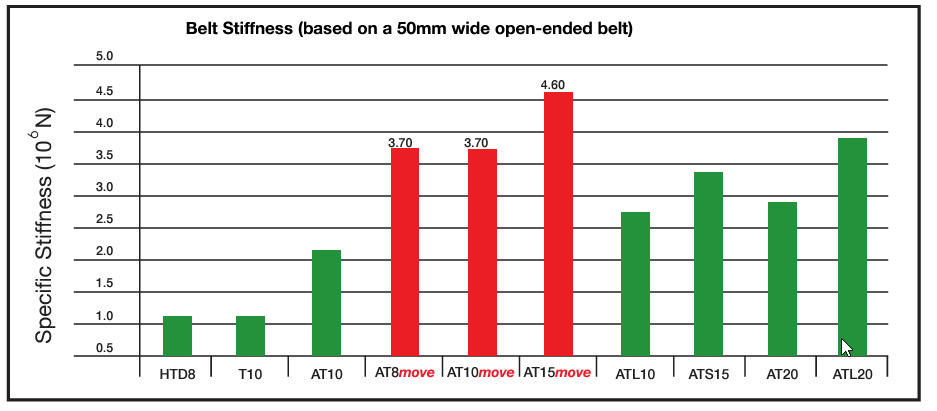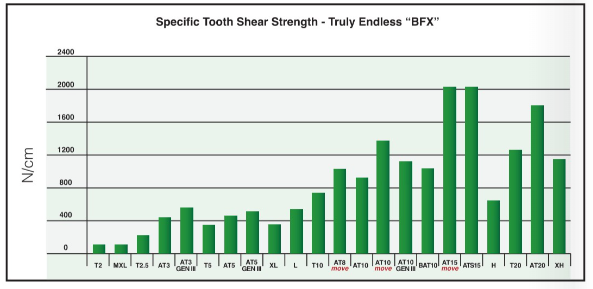
Allowable Tensile Strength – the maximum stress that can be applied to a timing belt without failure. Maximum point where cords would be within a safety factor and would return to their original length with no load.
Anti-Static – a timing belt coating that reduces or prevents the build-up of static electricity such as PAZ PAR Anti-static.
ARC Power – a patented arch shaped timing belt tooth that provide self-tracking. It is quiet running and provides continuous tooth engagement. When using ARC power, no pulley flanges are required. It is designated as BAT or BATK and comes in pitches 10,25 and 20.
Aramid Tension Members – also known as Kevlar, these tension members are non-metallic and have characteristics such as high tensile strength, high energy absorption, good temperature and chemical resistance.
AT Series – a metric trapezoidal tooth created by BRECO, is considered the industry standard for timing belt strength. The center-to-center pitch is the same as a T-series, but the tooth is wider.
ATL Series – an AT pitch timing belt with larger tension members, higher tensile strength, and spring rates. If offers near perfect tolerance.
ATN Series – An AT pitch timing belt with molded cavities in the teeth that accept the insertion and fastening of profiles.
ATN Connecting Kit - a field connection consisting of inserts, plates and screws that enable the use to assemble the timing belt without having to disassemble the machine. There are three kinds: The standard C, the DC which has a deep connection allowing the plates to be flush with the belt back and DP Pro which is made for use with screwed-on profiles.

ATP Series – ATP is a specific tooth profile designed for power transmission. It is used predominantly as a replacement belt on existing OEM equipment. New machinery should consider other AT options.
ATS Series – This series is made for the 15mm pitch. It incorporates a 15mm tooth with larger steel tension members for added strength in power transmission and greater repeatability and settling time in linear drive applications.
Backings – also known as coatings or covers, consist of a wide variety of materials that are adhered to the timing belt back for conveying applications. They provide added properties such as to increase or reduce friction, or provide cushioning.
Backlash – this is the “play” when the timing belt tooth engages with the pulley. The tiny bit of extra space allows the timing belt to engage easily with the pulley but can be a negative factor in applications requiring high accuracy and fast settling time. BRECOflex offers zero-backlash pulleys for applications that require higher accuracy.

"BFX" –In 1975, BRECOflex developed and patented production process for extruding truly endless timing belts. This process makes a superior bond between the polyurethane and the tension members. Tension members are helically wound and carry the full load throughout the entire timing belt length. Truly endless timing belts are known industry wide as BFX.
Bifilar Tension Cords– Tension members are laid side-by-side in alternating “S” and “Z” arrangements. This creates balance for true tracking.

Bushings – a bushing is an insert piece that is added to a pulley to allow the connection of different-sized shafts. There are keyed tapered bushings and keyless bushings.
Coefficient of Friction - ratio of the frictional force resisting the motion of two surfaces in contact to the normal force pressing the two surfaces together. Itis usually symbolized by the Greek letter mu (μ). Mathematically, μ = F/N, here F is the frictional force and N is the normal force.
Custom Pulley – a pulley that has been modified in any way including flanges, bolt hole, counterbore, keyway, lightening holes, mounting holes, setscrews, hub, snap ring, taper lock bushing, self-tracking guide, QD business, grooves and bores.
"DL" – the code that represents double sided.
"DR" – the code that represents added polyurethane thickness on the timing belt back.
Elongation (Spring Rate) – this is the stretch that occurs when the timing belt is placed under tension. Pretension and load mass affect elongation. BRECOflex timing belts and tension cords have low elongation while running and no permanent elongation, so no re-tensioning is required over time.
Field Welder – a portable machine used to weld timing belts in the field. When used by the instructions, welds made with a field welder match the strength of a factory weld.

Flanges – these are added to timing pulleys to allow straight tracking. Pulleys can have one flange or two. Flanges can be rolled on or screwed on, depending on the pulley size and material. They are typically made of zinc but are also available in steel when needed.
Guides (Self-tracking Guides) – Some timing belts can be extruded with a serrated tracking guide. All others can be modified with a solid guide, either K6 or K13.
HTD Belt – “High Torque Drive” belts have a rounded tooth rather than a trapezoidal tooth. They are recommended primarily for power transmission but are also available open ended or welded.
Kevlar (see Aramid)
Length Tolerance –the amount that the dimension is allowed to vary. Timing belt Length tolerances are specified in our B212 catalog on page 129.
Longitudinal Machining – any modification made along the length of the timing belt such as a groove or set of grooves along the length of the belt backing.
Move-Series – an exclusive BRECOflex timing belt consisting of an optimized and coated AT pitch timing belt with stronger tension members than standard timing belts. It offers 75%higher tensile strength and 30% higher transmissible force.
Open Ended M – a timing belt that is produced in rolls and cut to length. They have bifilar, parallel tension members and are used in linear drive applications.
Outside diameter –the diameter of a pulley measured at the top of the tooth.
PAR - A nylon coating on the back side of the timing belt
PAZ – A nylon coating on the tooth side of the timing belt
PAZ-PAR – nylon coating on both sides of the timing belt
Pinlock Field Connection - The pinlock timing belt consists of a finger spliced belts with holes and screws. You can also get a plate to hold the belts securely in place when screwing the pins. Precise waterjet cutting and machining make everything line up perfectly for easy assembly

Pitch – Pitch is the distance between two consecutive timing belt tooth centers. Pitch can be metric or English Pitch.
Pitch Circle Diameter – this is the diameter of the pulley pitch line position. The tension cord of the timing belt forms the pitch line of the timing belt. Thus, the Pitch Diameter (P.D.) of a timing belt pulley coincides with the pitch line of the timing belt meshing with it. Pitch circle diameter is calculated as follows: (pitch x number of teeth) / Pi (3.14159)
Polygonal Effect –polygonal effect in a timing belt induces belt oscillation and vibration. Certain belts such as ARC Power reduce polygonal effect because of the continuous meshing of teeth in the pulley.
Profiles – welded-on attachments used for conveying applications. BRECOflex has over 4000 profile molds. Profiles are also referred to as cleats or lugs.
Redflex Gen III –a high strength timing belt with 40% more tensile strength and 60% higher tooth shear strength. Mad of red polyurethane. Available in AT3, AT5, AT10 and ATP10. Not to be confused with move-series which is stronger.
Repeatability (positional repeatability) – a measure of how well a timing belt returns to a consistent position in response to repeated commands to reach a target position.
Root diameter –The diameter of the pulley measured at the gap of the tooth.
Self-Tracking Timing Belt – a timing belt with a longitudinal guide down the length of the belt. It can be down the center or offset. BRECOflex offers several self-tracking timing belts that are extruded with a serrated K6 or K13 tracking guide. All other belts can be modified with a polyurethane solid self-tracking guide. The advantage of self-tracking timing belts is that they don’t require pulley flanges and they are straighter running.
Specific belt mass– the mass of a timing belt in relation to its length and width. BRECOflex specifies specific mass in kg/m per 10mm of belt width, steel reinforced.
Specific stiffness– The stiffness of a timing belt in relation to its length and width. BRECOflex specifies specific stiffness per unit of width and length.

Spliced and Welded V - a belt construction preferred for conveying applications.
STD Timing Belt –STD stands for “super torque drive” which is a rounded tooth configuration that provides superior engagement.
Tensile Strength -the admissible tensile load on a belt cross-section. The force required to permanently elongate or break the tension members.
Tension Member –the steel, stainless steel, hi-flex steel or aramid (Kevlar) reinforcing cords that add strength and stiffness to timing belts. Each have specific characteristics that they add to the timing belt.
Tooth Engagement –where the belt tooth engages with the pulley tooth gap.
Tooth Shear Strength– how much power can be transmitted before the belt tooth tears away from the tension members. Specific tooth shear strength depends on the rotational speed. The maximum specific tooth shear strength is the load limit that the belt tooth can bear during continuous operation.

Ultimate tensile strength– the point at which the cord would see catastrophic failure and would lose tension.